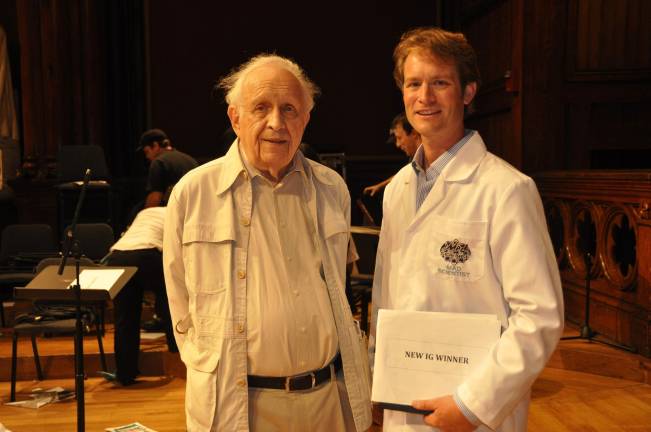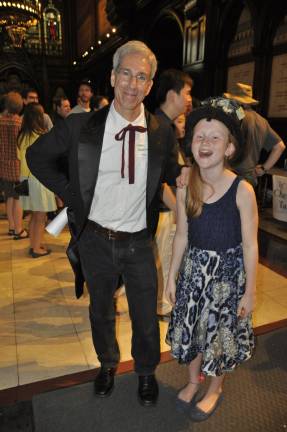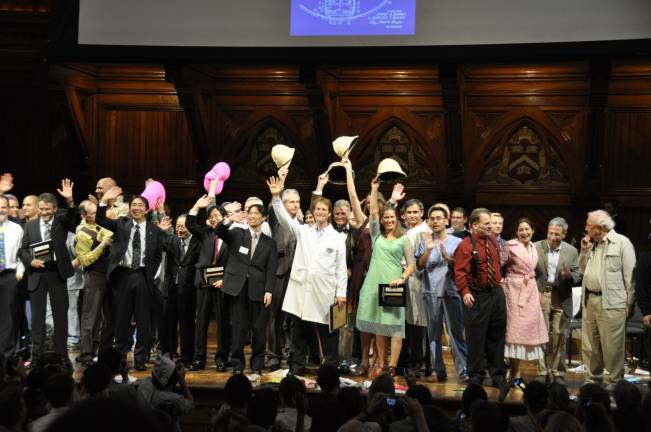If the shrew fits, swallow it




By Ginny Privitar
GOSHEN — Goshen’s own Brian Crandall, who runs Mad Science of the Mid-Hudson, was honored Sept. 12 at Harvard University with the Ig Nobel p=rize in Archaeology for research he did as an undergraduate at Binghamton University.
The 23th annual awards ceremony honors real research "that first makes people laugh, and then makes them think. The prizes are intended to celebrate the unusual, honor the imaginative — and spur people's interest in science," according to its website.
But lest you think this is merely a joke, the ceremony took place at Harvard’s Sanders Theater, hosted by the Annals of improbable Research and several Harvard University student groups. Genuine Nobel laureates were on hand to give out the coveted prizes in a joyful celebration of science.
According to Crandall, someone — he has no idea who — submitted his research paper "Human Digestive Effects on a Micromammalian Skeleton,” which he co-authored with his professor, Peter W. Stahl, back in 1995. It was one of approximately 9,000-plus submissions winnowed down to only ten.
'Someone ate a shrew'
In the 1990s, while working on his bachelor of science in biology and anthropology, Crandall came up with a novel idea for his senior research project. His professor, Peter Stahl, was enthusiastic about the idea.
Crandall knew that micromammalian bones were found at many archaeological sites once occupied by humans.
“People would find these small shrew bones and didn’t know how to interpret them," he said. "If you find some of these bones, were they just living side by side with us or were we eating them? Before this study people had spent a lot of time feeding shrews to owls, hawks, foxes, cats, etcetera.”
“Scientists would compare the bones they found to digestive signatures of these predators and they didn’t fit, so by a process of elimination, they would say, ‘Maybe these were eaten by humans,'" he said. "No one had looked at humans.”
These animals have been and continue to be part of the human diet in many parts of the world.
Crandall decided to find out what the remains of a shrew looked like after it passed through the human digestive system. He does not identify himself or Stahl as the lead researcher. All he will say is: “Someone ate a shrew.”
The shrew was parboiled and swallowed whole to eliminate any bias based on the way it might have been eaten in different cultures. It also minimized damage due to chewing.
The next part of the study was perhaps more daunting. After passing through the digestive system, the remains were carefully collected, cleaned and studied. Crandall found that, after digestion — even without chewing — most of the bones, including leg bones, vertebrae and teeth were missing and others, like the skull, were severely damaged. The damage pattern demonstrated by the recovered bones is an additional tool for use by archaeologists when attempting to interpret the bone assemblages found at archaeological sites.
Scientists just want to have fun
Professor Stahl, nowteaching at the University of Victoria in British Columbia, Canada, was unable to attend the awards ceremony because of his teaching responsibilities. But Crandall was there.
Being surrounded by real Nobel laureates was somewhat intimidating, Crandall said.
“The most amazing thing on that stage at Harvard — there were a million years of education and everyone was there to celebrate the fun side of science," he said. "Everyone checked their ego at the door and there was no pomposity. Everyone was there just to enjoy the moment.”
After college, Crandall intended to go to graduate school for anthropology, but, as he says, “Life led me a different way.” After graduating, he traveled for a year with Up With People, a musical theater and intercultural learning service group that traveled across the United States and to six European countries.
“In each town, we performed a show and did community service work while staying with local host families,” Crandall said. “It was an awesome experience.”
It was also where he met his wife, Jennifer.
After Up With People, he moved to Indiana to be with Jennifer. He was a classroom teacher briefly, but fate intervened. That’s when he “stumbled upon" Mad Science. He took a job as a manager at Mad Science, a business that schools hire to teach science in a creative way as a supplement their curriculum.
“I thought it would be a temporary thing," Crandall said. "A year later, we moved back here to start Mad Science of the Mid-Hudson, and it has been growing steadily for the last 14 years.”
He considers himself an independent educator and he loves his job. He has brought his brand of science education to about 100 schools in the past year alone.
“You can teach serious science but approach it in a way that will hook children," he said. "We don’t feed shrews to children at schools. However, one of the things we do at school is recover bones from owl pellets.”
Crandall is also a member of the Parent-Teacher Organization in Goshen, where his daughter Katie, 11, attends fifth grade. Katie accompanied her father to the award ceremony at Harvard. Crandall said the renowned science writer and master of ceremonies for the Ig Nobel Awards, Marc Abrahams, came up to Katie and asked how she was, and then posed for a photo with her.
Cash Award and a lecture tour, too
Besides the recognition for his research, including a plaque and a certificate signed by Nobel Prize winners, Crandall was presented with a cash award: a single bill with the face value of ten trillion Zimbabwean dollars. Unfortunately, the currency is no longer valid. Who says scientists don’t have a sense of humor?
Part of the fun of the experience, Crandall said, is that he now has the opportunity to take his lecture on the road. After the awards ceremony, he gave a lecture at MIT on his research, attended by approximately 800 people. He’s been invited to Chicago in Feb. 2014 for the American Association for the Advancement of Science Annual Conference. As part of the “Ig-Informal Lecture Series,” he and some winners from previous years will also go to Washington, D.C., in April and possibly do a lecture tour of the United Kingdom, Denmark and Sweden in March 2014.
Media outlets from Brazil, Sweden and Germany have interviewed Crandall. The Discovery Channel sent a video crew to interview him this month.
A few of the other winners include: a group of international authors, including Marie Dacke, Emily Baird, Marcus Byrne, Clarke Scholtz and Eric J. Warrant, who won the joint prize in Biology and Astronomy for explaining how dung beetles use the Milky Way to navigate their way home, and Matsateru Uchiyama of Japan, who won the Ig-Nobel prize in Medicine, for assessing the effect of listening to opera on heart transplant patients who are mice. (1136)
Crandall acknowledges that he's always wanted to replicate his shrew study. "It would be great to have a larger research sample," he said.
Perhaps some intrepid college students would care to advance his research?